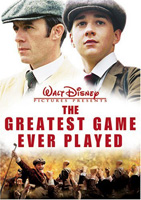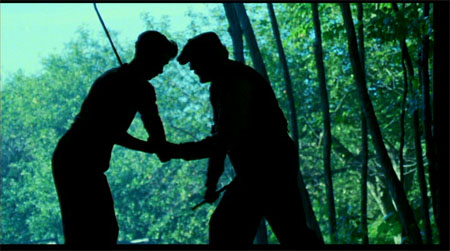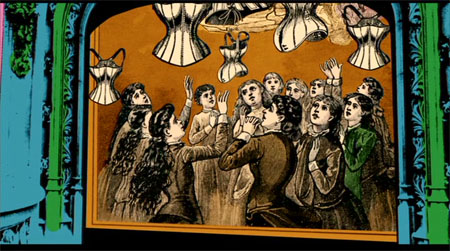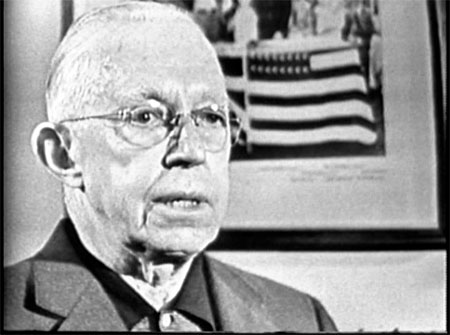 BUY IT AT AMAZON: CLICK HERE!
BUY IT AT AMAZON: CLICK HERE!
STUDIO: Disney
MSRP: $29.99
RATED: PG
RUNNING TIME: 121 Minutes
SPECIAL FEATURES:
• Audio commentaries by Bill Paxton and Mark Frost
• Featurettes
• Sneak Previews
The Pitch
The inspirational story of how a young amateur won the 1913 US Open and made golf an everyman’s game. That is, if everyman has a course to play on, the money necessary to pay for golf clubs, the money necessary for lessons, the proper attire…
The Humans
Shia LaBeouf, Stephen Dillane, Peter Firth and Elias Koteas.
The Nutshell
Golf was still in its infancy back in 1913. The game had become quite popular in Britain but was still a minor curiosity back in the United States. The most popular golfer at this time was British player Harry Vardon. Vardon came from a working class background to become one of golf’s greatest champions and pioneers. However, Vardon’s career was sidetracked by a battle with tuberculosis. The winner of the 1900 US Open, Vardon would not return to compete in it again until thirteen years later.
Also hailing from a working class background was 20-year-old amateur golfer Francis Ouimet. Ouimet grew up right across the street from the country club in Brookline, Massachusetts. He worked there as a caddie during his childhood and was given the chance of a lifetime when the 1913 US Open was held there. Expected to fare poorly against professional golfers, Ouimet shocked the sporting world by holding his own against Vardon and the rest of the field, ultimately becoming the first amateur to ever win the championship.

Before an amateur golfer can turn pro he must slay his master in combat.
The Lowdown
It’s difficult to make a sports movie. It’s difficult to put the audience in the same time period in which the sporting event occurred. It’s difficult to make an audience realize just how meaningful and powerful the event was. It’s difficult to make an audience recognize that something so commonplace and taken for granted in today’s day and age was once thought of as impossible.
The difficulty of crafting an exceptional sports movie can lead any director to doubt their own abilities. What if you can’t get the audience to appreciate the monumental nature of the sporting event? What if they don’t sympathize with the character at the appropriate times? What if they don’t understand how the character’s actions had effects on the sport that are still being felt to this day?
This train of thought leads a director to craft their film in such a way that it cannot be misinterpreted. The audience will have no choice but to sympathize with the main character when he is down on his luck. Sorrowful string music will play in the background during his times of adversity and his own family members will admonish him for following his dreams. The audience will have no choice but to cheer for the character as he wins the championship. Fans will carry him on his shoulders as his once disapproving father looks on with a tear in his eye.
Each moment of The Greatest Game Ever Played has been constructed to pull a precise emotion out of a viewer at the precise time it is needed. No sports cliché is left untouched in the film’s quest to make you cheer on Francis Ouimet as he is laughed at by high society and frowned upon by his own father. If you’ve seen even a handful of sports films you’ll be able to easily predict exactly what happens in each scene. Every scene in the film is so calculated that is almost ceases to be a film at all – it’s a math equation.

At night the corset fairy would visit young women and welcome them into a world of pain and discomfort.
The only miscalculation in this equation is its length. The film arrives at the historic 1913 US Open championship in less than an hour. The tournament itself lasts nearly 70 minutes. Rarely does a sports film devote such a long amount of time on the climactic event. The audience isn’t stupid. The film is based on a true sporting event and even if it wasn’t, it’s abundantly clear who the victor will be. Seventy minutes spent hurtling towards the inevitable conclusion is far too long and the film has used up every cliché in the book before the championship is even close to over.
The running time of the film would have been even more excruciating if not for director Bill Paxton’s efforts to spruce up the game of golf. Golf is difficult to get excited over in real life, let alone in a film. In order to hold the audience’s attention span, Paxton has infused his 1913 period piece with a ton of CGI effects. Golf balls shoot for miles with the camera following their every movement. Tiny ladybugs land on top of golf balls before getting knocked around. Each fancy effect seems to be an apology for how mundane the game itself is and an invitation to look at something shinier and fancier instead.
Shia LaBeouf does a much better job in the central role of the film than he has in his other work. It’s one of the first times he’s been asked to carry a film instead of being the inquisitive young sidekick. He’s old enough to have his own sidekick now in the form of Josh Flitter. He’s the young caddy who calms Shia’s nerves and creates predictable comedic relief by shocking the aristocratic players with his crude behavior. The supporting cast performs as well as they need to in the one dimensional roles the story allows for.
The Greatest Game Ever Played does mediocre well. The film is shot well, the score evokes the right emotions and the actors get the material across. The trouble is that they spent all their efforts making a good looking but highly predictable and manipulative sports film. The best executed mediocre film is still a mediocre one – it just looks prettier.

Stupid cgi bugs putting the hardworking real bugs out of a job.
The Package
Most of the features on the disc focus on the true story of Francis Ouimet, free of the changes made to his story in the film. In the Two Legends and the Greatest Game featurette, a narrator recounts the events that lead Ouimet and Vardon to the 1913 US Open. The visuals for this segment include various film clips and historic photographs from the period. From Caddy to Champion: Francis Ouimet is a vintage interview with Ouimet himself. Ouimet had retired in his old age at this point and recounts his history in the game of golf. He also goes into the various ways the game has changed since his days from rules to equipment.
The left over features focus on the film itself. A View from the Gallery is the standard behind the scenes featurette on the film’s production. Cast and crew wax poetic about how great the film was to work on and the way Bill Paxton runs a movie set. Bill Paxton’s commentary track focuses on the film’s production while author Mark Frost’s track focuses on the true events the film was based on. Both men are engaging and seem excited to talk about the film.

They got the kid from Even Stevens to play me? I think I’d like to die now.
The cover art reuses the original poster art but adds floating heads of the two protagonists to the top. The floating heads approach seems a little odd for a film with such little star caliber. Perhaps Disney hopes to cash in on the Shia LaBeouf fan base of preteen girls.